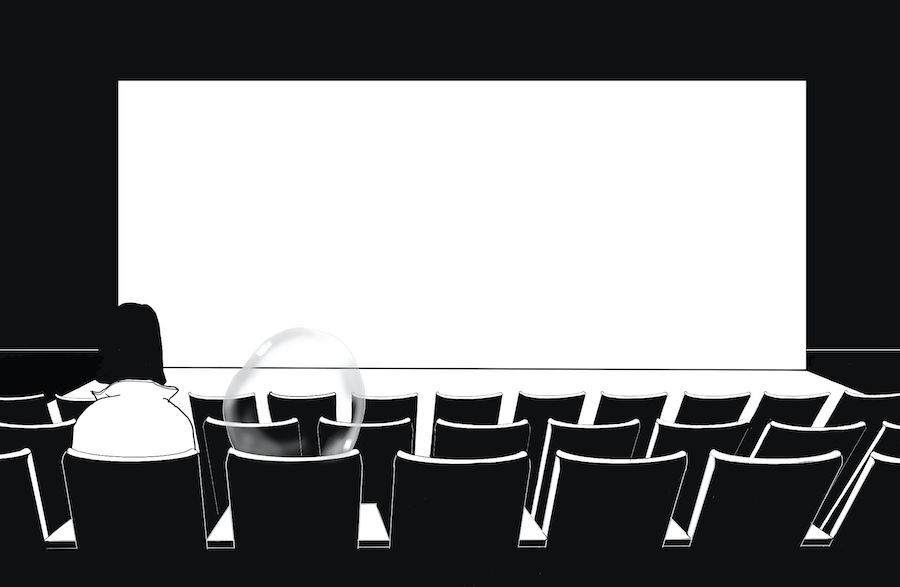In the midst of a global pandemic and national protests stemming from the murder of George Floyd, one New York City theatre is working to ensure that a vulnerable group of artists is not lost in the shuffle: theatrical designers on work visas. This class of theatre workers is challenged in three ways: by the pandemic-induced isolation and limited creative opportunities that affects everyone in their field, by the fact a shift to online programming can often sideline design elements, and by the fact that work visas for these non-U.S. citizens hinge on holding the jobs that are suddenly out of reach.
The Movement Theatre Company in New York City has stepped in to help, lauching the 1MOVE: DES19NED BY… series to promote the work of emerging non-citizen designers of color whose livelihoods have come to a screeching halt. Fifteen artists, including scenic, costume, lighting, sound, and projection designers, have been commissioned to create the first installment of the series, to launch today, June 8. Curated by Tony Award-winning costume designer Clint Ramos and lighting designer Cha See, the standalone pieces, which comprise two- to five-minute videos, are accessible for free through the Movement’s website as well as its YouTube page.
The concern first arose, said David Mendizábal, one of the producing artistic leaders of the Movement, when he noticed that as theatres shift to online readings and Zoom plays, designers have largely slipped through the cracks. “We’re hearing beautiful work by actors and beautiful writing, but we’re missing that visual element that’s so exciting about going to a theatre,” he said. What’s more, Ramos noted, “Most of the grant-giving bodies, both individual and institutional, do not cover designers. Playwrights get a lot of grants, directors get a lot of grants, actors get a lot of grants, but designers for some reason are just sort of ignored.”
The new 1MOVE commissions don’t just give financial support but unique creative freedom as well. As Mendizábal put it, they allow designers “to introduce us to 15 different worlds, and what will emerge when the designer is given the freedom to tell their own story.” The resulting works address not only the COVID-19 pandemic but also issues surrounding racism, patriarchy, and white supremacy, Mendizábal said. Where theatrical designers usually work behind the scenes and within the dictates of show written and directed by others, these commissions put both their ideas and their artistry in the spotlight.
“It’s a good start for artists of color to share opinions and also to serve as an experiment for creating content in a time when we are on shaky ground,” said one of the commissioned artists, Chinese set designer and visual artist Ao Li. His animated video explores how public spaces like movie theatres and parks will change in the wake of the pandemic.
Stefania Bulbarella, a multidisciplinary designer, said she is particularly pleased that her family and friends in Argentina will now have the opportunity to see her work. “We’re our own playwrights, we’re our own directors, we’re our own projection designers, and we can create whatever we want,” she said. “I’m really happy to be part of this and can’t wait to share it with the world.” Her piece, titled Closure, explores the catharsis she’s felt while reinventing herself during the pandemic.

Started in 2007, the Movement Theatre Company is dedicated to developing and producing new work by artists of color. Its 1MOVE series actually launched in 2017 as a way to create and share online content about contemporary human rights and social issues. This round of commissions is made possible through a grant from the artEquity + Activist Community Fund.
Each of the designers holds either an O1-B visa (for individuals who demonstrate an extraordinary ability in the arts) or an OPT visa (an optional practical training extension of their F-1 student visas). These visas do not allow them access to federal aid programs, like Medicaid or unemployment benefits, that U.S. citizens receive, and their lack of employment can jeopardize their visa status, especially if they are in the process of applying for a new visa. A six-month lapse in employment is grounds for deportability for someone on an O1-B visa, Ramos said.
His fellow curator, See, explained the risk and mental toll of being an immigrant during the pandemic. “Pre-corona, we were already very vulnerable because, 1) we’re freelancers, and 2) we’re immigrants, 3) we’re designers. We are backstage people. Now that this corona is happening, we have to think about the paperwork,” said See, who was raised in Manila, Philippines, and has been in the United States since 2014. “It’s always anxiety-provoking. Should we say goodbye to seven years of hard work? It’s hard to leave behind a country, and it’s harder to be in a country where all we know is that help is not being provided to us.”
Still, the designers have continued to create despite the resources unavailable to them.
“It’s hard because you feel a little bit left behind,” said British-Egyptian costume designer Dina El-Aziz, who was in tech for Mona Mansour’s The Vagrant Trilogy at the Public Theater when the shutdown closed its doors in March. “I just want to remind people that we exist. We’re talented. We deserve to be here.” Her DES19NED BY… piece, Diary of a Quarantined Costume Designer, is an animated story about going to the grocery store during the pandemic.
El-Aziz isn’t the only designer creating a video inspired by pandemic experiences. Megumi Katayama, a sound designer from Japan, was inspired by the nightly shift-change applause for medical personnel that ricochets through cities. She called the 7 p.m. celebration “a moment of connection” and the “soundscape of different rhythms of different people,” like the ones that usually accompany live theatre, and she was drawn to the idea of telling a positive coronavirus story despite all the negatives. The DES19NED BY… commission gave Katayama the opportunity to work in a new medium, and to add writing, directing, and research to her toolkit. “We all have skills of being able to collaborate and tell other people’s stories because we know the power of storytelling—not just providing information, but to really tell the story,” she said.
Ramos second the notion of designers as storytellers. “One of the goals is to create awareness to the needs of the designers and how designers are actually a really integral part of theatremaking,” he said.
This gallery will continue to increase visibility throughout the summer: A virtual meet-the-artist event will take place on June 16 at 4 p.m., and a second round of works has been commissioned for July and will be co-curated by Paul Tazewell, Dede Ayite, and Stacey Derosier.
With the pandemic isolating friends and families, and with advocates for racial justice crowing the streets, the DES19GNED BY… gallery draws attention to yet another community that’s part of the tapestry of the American theatre. The collection highlights designers, diverse in both discipline and background, to champion their creativity and their contributions.
“We are people from everywhere around the world, with our own culture and voices and colors and rhythms,” Bulbarella said. “This is a moment to create work that belongs to us. And we want to share it.”
Kate Mazade is a Goldring Arts Journalism graduate student at Syracuse University.









